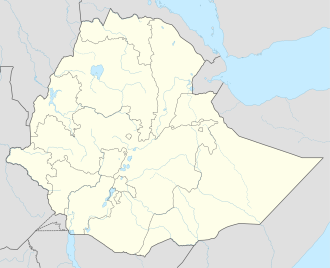The Ethiopian retreat
Having learned of the maneuver implemented by the Italians and worried that the remnants of the imperial army could remain stuck in the trap created by Badoglio, Hailé Selassié ordered the 20,000 men he had left to retreat in an orderly manner towards Quoram. Hailé Selassie, wearing a pith helmet and riding a white horse, then began his retreat in an orderly manner, attacked by the Azebo Galla tribes on the flanks of the Ethiopian army. [2] [3] However, due to the lack of supplies and the heavy defeats suffered, the army began to dissolve and the men ended up no longer obeying the orders of their leaders, advancing without any guide on the steep mountain paths that sloped down to the dangerously exposed basin of Lake Ashenge due to the lack of vegetation. [1]
Pietro Badoglio's "trap"
In the meantime, Badoglio, having learned that the Ethiopians troops were in retreat, decided to finalize the victory at Maychew as much as possible to definitively rout what remained of the last Ethiopian army on the northern front.
Already on the 2nd of April he ordered General Vincenzo Magliocco to throw the entire air force of the Eritrean colony or the Air Bombardment Brigade [4] in pursuit of the Ethiopian troops, expressly asking that "All aviators take to the skies and give no respite to the enemy. Tell them on my behalf that they will eat in forty-eight hours." [1] On the same day the Italian bombers dropped 26.3 tons of explosives on the positions held by the Ethiopian rearguard troops, and on 3 April they dropped another 16.8 tons, again countered by the Ethiopian anti-aircraft fire which damaged 14 aircraft. [1]
On April 4, 150 Italian planes surprised the retreating army near the shores of Lake Ashenge at first light. In a completely exposed position and without air cover, the Armed Ethiopian Columns who had recklessly moved during the day on the only path that runs along the left bank of the lake, also because they were followed from behind by Ruggero Santini's men and those of Alessandro Biroli, became easy prey for the Italian air force. [1]
Throughout the day, 155 aerial actions were carried out with the dropping of 70 tons of bombs, many of which were loaded with mustard gas, and 20,000 machine gun shots were fired. On the other hand, the Ethiopians hit 28 aircraft, shooting down one. [1] In addition to the action of the air force, the Ethiopian troops had to face the ambushes of the Azebo Galla tribes who attacked them during the entire retreat march, up to the gates of Quoram, while the Ethiopian rearguard was hammered by the artillery of the 1st Eritrean Division of general Gustavo Pesenti which in the afternoon had appeared on the mountains around Mecaré and which had quickly placed the artillery to strike the enemy troops, reporting at the end of the day the loss of 15 men against thousands losses inflicted on the Ethiopians. [1]
In the meantime, the emperor had found refuge in a cave in the mountains north of the lake in the Mariam Aschenge area, from where he was able to observe the following day the banks of the lake fringed by the bodies of the wounded from the day before who had been killed by drinking the water poisoned with toxic gases. [1]
